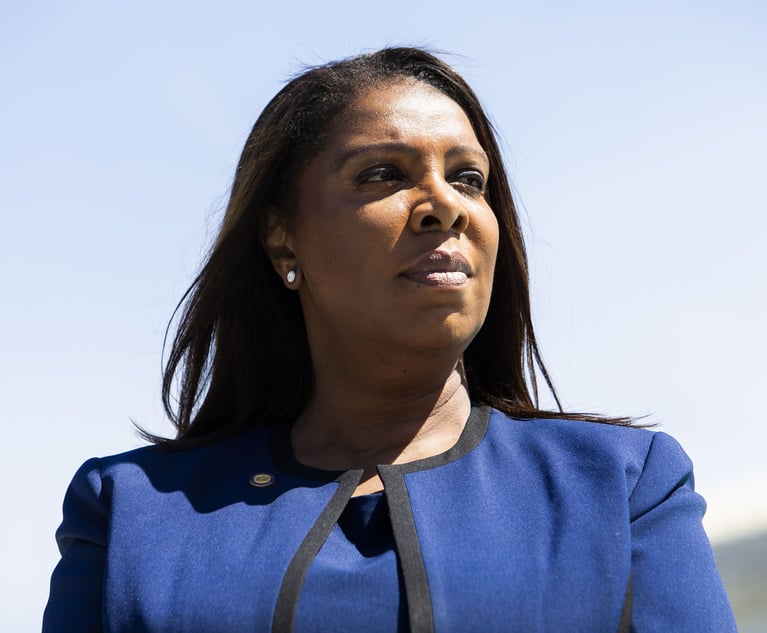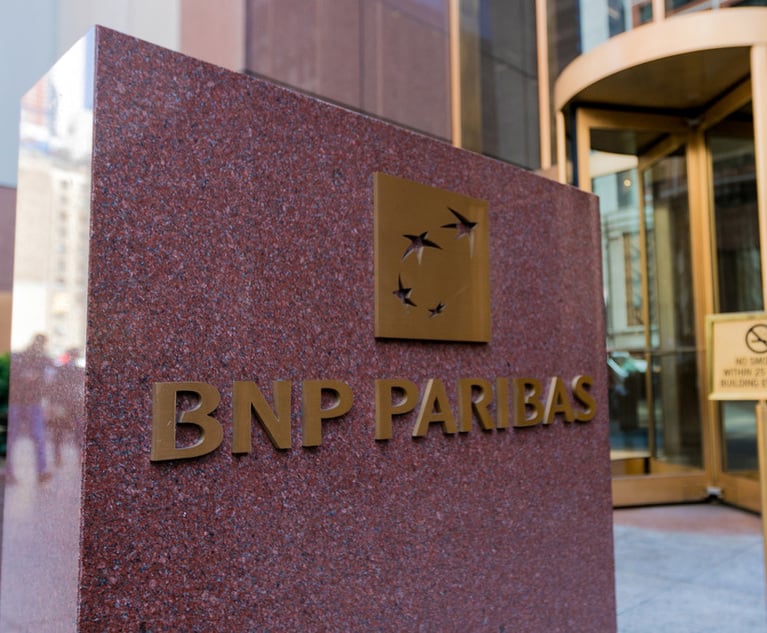Goldman Sachs Asks for En Banc Rehearing of Class Certification Ruling
Goldman and its Sullivan & Cromwell attorneys said a ruling from a divided panel of the Manhattan-based appeals court, was at odds with Supreme Court precedent holding that defendants must be given a chance to rebut the presumption of class-wide reliance on supposed public misrepresentations before a class is certified.
May 14, 2020 at 05:50 PM
4 minute read
 Image: Shutterstock.com
Image: Shutterstock.com
Goldman Sachs has asked the full bench of the U.S. Court of Appeals for the Second Circuit to review a panel decision allowing class certification in a long-running securities fraud suit over statements the investment bank made regarding alleged conflicts on its board.
In a petition for en banc rehearing, Goldman and its Sullivan & Cromwell attorneys said Tuesday that the April 7 ruling, from a divided panel of the Manhattan-based appeals court, was at odds with Supreme Court precedent holding that defendants must be given a chance to rebut the so-called Basic presumption of classwide reliance on supposed public misrepresentations before a class is certified.
The move, though bolstered by one judge's dissenting opinion, is a long shot in a circuit known for avoiding en banc rehearings. However, it could potentially set the stage for a certiorari petition to the Supreme Court.
The Second Circuit's majority opinion found that Goldman's statements that it was "conflict-free" maintained its artificially inflated stock price, which later declined after a series of corrective disclosures announcing investigations and fines over allegedly fraudulent trading practices.
The panel also rejected Goldman's argument that allowing class actions on "general" misstatements would open firms to a flood of baseless securities fraud litigation.
"We are not blind to the widespread understanding that class certification can pressure defendants into settling large claims, meritorious or not, because of the financial risk of going to trial," Judge Richard C. Wesley of the U.S. Court of Appeals for the Second Circuit wrote.
"This would indeed be troubling. But our law already beats back this parade of horribles," he said.
The ruling, however, came over the strong object of U.S. District Judge Richard J. Sullivan of the Southern District of New York, who said the majority's decision would make the fraud-on-the-market presumption "truly irrebuttable" and class certification "all but inevitable in every case" in the Second Circuit, which is home to the nation's securities markets.
Goldman's filing Tuesday seized on the language of Sullivan's dissent to argue for rehearing before the circuit's full complement of active judges.
Goldman attorney Robert Giuffra Jr. argued that the Supreme Court's 2014 decision in a case known as Halliburton II held that defendants to securities class actions can rebut the presumption with "any showing" that the alleged misstatements had no "price impact" on a company's stock.
Giuffra's filing cited evidence Goldman had presented to prove that the market was "indifferent" to statements it argued amounted to nonactionable corporate puffery.
For instance, Giuffra said, 36 contemporaneous news reports detailing allegations of Goldman's client conflicts had no measurable impact on the firm's stock price, bolstering the case that the eventual dip was the result of government enforcement actions against Goldman—and not the allegedly misleading disclosures.
"If such evidence, combined with the generic nature of defendants' challenged statements and this court's decisions holding that investors would not attach significance to such statements, is not enough to rebut [the Basic presumption], then no showing ever could," Giuffra wrote.
He continued: "If the majority's decision stands, Halliburton II is a dead letter in this circuit. Going forward, plaintiffs seeking class certification in the most important Circuit for securities fraud cases will claim only that a company's generic statements about its business principles and risk controls—which virtually all companies make—'maintained' inflation in its stock price and then point to a stock drop at the end of the class period."
Goldman's potential exposure in the case runs into the billions of dollars.
The case, captioned Sorkin v. Goldman Sachs, has garnered significant interest from business leaders, economists and academics, who have lined up on opposite sides of the litigation. Amicus briefs on the en banc request are expected to be filed next week.
An attorney for the plaintiffs did not immediately respond to a request for comment.
READ MORE:
2nd Circuit Refuses Rehearing of Decision Barring Trump From Blocking Twitter Users
This content has been archived. It is available through our partners, LexisNexis® and Bloomberg Law.
To view this content, please continue to their sites.
Not a Lexis Subscriber?
Subscribe Now
Not a Bloomberg Law Subscriber?
Subscribe Now
NOT FOR REPRINT
© 2025 ALM Global, LLC, All Rights Reserved. Request academic re-use from www.copyright.com. All other uses, submit a request to [email protected]. For more information visit Asset & Logo Licensing.
You Might Like
View All
The CFPB Is Digging In for Last Days of Biden's Term. But What Happens Next?
6 minute read

NY AG James Targets Crypto Fraud Which Allegedly Ensnared Victims With Fake Jobs
4 minute read
'Merciless' Filing Deadline Dooms Cuban Americans' Property-Trafficking Suit Against BNP Paribas, SocGen
4 minute readLaw Firms Mentioned
Trending Stories
- 1SDNY Criminal Division Deputy Chief Returns to Debevoise
- 2Brownstein Adds Former Interior Secretary, Offering 'Strategic Counsel' During New Trump Term
- 3Tragedy on I-95: Florida Lawsuit Against Horizon Freight System Could Set New Precedent in Crash Cases
- 4Weil, Loading Up on More Regulatory Talent, Adds SEC Asset Management Co-Chief
- 5Big Banks Did Great Last Year. What Does That Mean for Big Law?
Who Got The Work
J. Brugh Lower of Gibbons has entered an appearance for industrial equipment supplier Devco Corporation in a pending trademark infringement lawsuit. The suit, accusing the defendant of selling knock-off Graco products, was filed Dec. 18 in New Jersey District Court by Rivkin Radler on behalf of Graco Inc. and Graco Minnesota. The case, assigned to U.S. District Judge Zahid N. Quraishi, is 3:24-cv-11294, Graco Inc. et al v. Devco Corporation.
Who Got The Work
Rebecca Maller-Stein and Kent A. Yalowitz of Arnold & Porter Kaye Scholer have entered their appearances for Hanaco Venture Capital and its executives, Lior Prosor and David Frankel, in a pending securities lawsuit. The action, filed on Dec. 24 in New York Southern District Court by Zell, Aron & Co. on behalf of Goldeneye Advisors, accuses the defendants of negligently and fraudulently managing the plaintiff's $1 million investment. The case, assigned to U.S. District Judge Vernon S. Broderick, is 1:24-cv-09918, Goldeneye Advisors, LLC v. Hanaco Venture Capital, Ltd. et al.
Who Got The Work
Attorneys from A&O Shearman has stepped in as defense counsel for Toronto-Dominion Bank and other defendants in a pending securities class action. The suit, filed Dec. 11 in New York Southern District Court by Bleichmar Fonti & Auld, accuses the defendants of concealing the bank's 'pervasive' deficiencies in regards to its compliance with the Bank Secrecy Act and the quality of its anti-money laundering controls. The case, assigned to U.S. District Judge Arun Subramanian, is 1:24-cv-09445, Gonzalez v. The Toronto-Dominion Bank et al.
Who Got The Work
Crown Castle International, a Pennsylvania company providing shared communications infrastructure, has turned to Luke D. Wolf of Gordon Rees Scully Mansukhani to fend off a pending breach-of-contract lawsuit. The court action, filed Nov. 25 in Michigan Eastern District Court by Hooper Hathaway PC on behalf of The Town Residences LLC, accuses Crown Castle of failing to transfer approximately $30,000 in utility payments from T-Mobile in breach of a roof-top lease and assignment agreement. The case, assigned to U.S. District Judge Susan K. Declercq, is 2:24-cv-13131, The Town Residences LLC v. T-Mobile US, Inc. et al.
Who Got The Work
Wilfred P. Coronato and Daniel M. Schwartz of McCarter & English have stepped in as defense counsel to Electrolux Home Products Inc. in a pending product liability lawsuit. The court action, filed Nov. 26 in New York Eastern District Court by Poulos Lopiccolo PC and Nagel Rice LLP on behalf of David Stern, alleges that the defendant's refrigerators’ drawers and shelving repeatedly break and fall apart within months after purchase. The case, assigned to U.S. District Judge Joan M. Azrack, is 2:24-cv-08204, Stern v. Electrolux Home Products, Inc.
Featured Firms
Law Offices of Gary Martin Hays & Associates, P.C.
(470) 294-1674
Law Offices of Mark E. Salomone
(857) 444-6468
Smith & Hassler
(713) 739-1250






